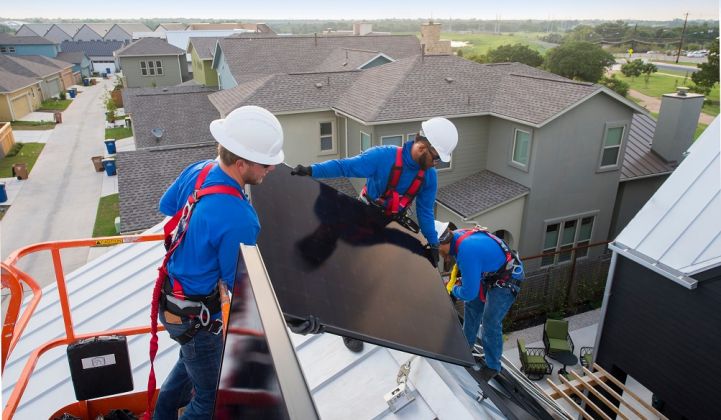SunPower swung to a slight and predicted loss in the third quarter of 2019, amid a yearlong restructuring that’s taken the solar manufacturer and installer out of the utility-scale solar business and into distributed solar and storage.
SunPower on Wednesday reported a net loss of $15 million on revenue of $476 million for Q3, compared to a net profit of $121.5 million on revenue of $436.3 million in the previous quarter and an $89.8 million loss on revenue of $428.3 million in the third quarter of 2018. Its fiscal year 2019 guidance predicts a net loss of $20 million to break-even earnings on revenue of $1.8 billion to $2 billion, in GAAP terms.
In an interview, CEO Tom Werner said the results are in line with the restructuring plan, launched last year, that has shifted SunPower’s focus from utility-scale solar to distributed residential and commercial solar, solar-plus-storage and solar-plus-storage-plus-services.
“I think we’re showing signs of benefiting from the restructuring we’re doing,” Werner said. “That part of the business is growing quite rapidly.”
Both the residential and commercial segments showed sequential growth in the quarter, including record bookings for PV for homes being built through partnerships with homebuilders ahead of California's imminent solar mandate for new homes.
But SunPower, majority-owned by French oil giant Total, also put up record shipments into international distributed generation markets in the third quarter, Werner said during Wednesday’s conference call. International sales made up more than 70 percent of total volume, with strong growth in Europe, South Korea, Australia and Southeast Asia.
SunPower continued to ramp up production of its new Maxeon 5 solar panels and is finalizing investment to scale up further in the fourth quarter, Werner said. The company’s P-Series commercial solar panels, being made at facilities in Oregon and China, are on track for 1.3 gigawatts of shipments for the year, he added.
As for energy storage, demand for SunPower’s Helix storage systems for commercial and industrial customers remains high since last year’s introduction, with about 30 megawatts of contracts awarded and approximately 145 megawatts in the pipeline, Werner said. Attach rates for the Helix offering stand at roughly 35 percent, meaning that more than one out of every three customers are choosing to add batteries to their solar system.
Last month, SunPower started taking initial orders for its Equinox residential storage system, in advance of a national rollout late in the first quarter of 2020, Werner said. That will offer customers “more freedom from utility outages," with modular units of storage available. Based on initial orders, SunPower is projecting 25+ percent attach rates for the Equinox storage offering, with a significantly higher rate possible in California.
This month’s unfolding power outage emergency facing Northern California customers of bankrupt utility Pacific Gas & Electric could drive an increase in demand for battery-backed solar systems, although it’s too early for data to show whether that’s actually happening.
In the longer term, California regulators have already earmarked $100 million in incentives for battery-solar systems for low-income and medically vulnerable residents of the state’s most at-risk fire zones, and they are considering further investments in grid resiliency.
SunPower’s Equinox is the latest in a growing number of integrated solar, inverter, battery and energy management packages being offered by major manufacturers and installers. But according to Werner, it’s the “only fully integrated residential storage system designed, engineered and warrantied by a single company, which we see as an important advantage.”
SunPower shed its utility-scale pipeline last year to restructure around several core areas: its manufacturing arm, known as SunPower Technologies, and its commercial and residential energy services divisions, known as SunPower Energy Services. Under a new reorganization announced Wednesday, large commercial and industrial customers will continue to be served directly, while its smaller commercial, residential and new-home-builders channels will be served through indirect channel partners.




